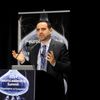
History is often made when adversaries with well-established biases overcome expectations to find common ground: Ronald Reagan negotiating arms reduction with Mikhail Gorbachev, Anwar Sadat and Menachem Begin signing a peace treaty between Israel and Egypt, or Saudis joining the first Iraq War coalition as staunch allies. These events become history because they are so unusual. When enemies beat their swords into ploughshares, it is front page news.
That's one reason President Obama's bromance with Governor Chris Christie of New Jersey remains an enduring story from the 2012 presidential campaign, an example of unexpected cooperation across a cultural and political divide that shaped countless narratives since the early 2000s. The two political leaders toured the Shore, met victims, and continued to cooperate with ease during the entire crisis. While we don't know what strategic machinations played out behind the scenes, this televised news drama left millions of us with a powerful visual reminder that bipartisan cooperation is possible.
However, research shows us that uniting against an overwhelming outside "enemy" such as a killer storm is easier to do than negotiating successfully with entrenched opponents to address complex, abstract policy issues such as deficit reduction. What's more, the American political realm is comprised of strongly polarized factions around budget and fiscal issues.
But if we are to avoid the so-called fiscal cliff arriving in 2013 (a neologism for a package of spending cuts and tax hikes that will take place on January 1 absent a new budget and tax deal -- a trigger agreed to in 2011 when deficit reduction talks broke down), President Obama could benefit from understanding what brain research tells us about building coalitions and finding agreement with people we perceive as being in our "out-group." (An out group member is someone you perceive as different to you, with different goals, a foe, someone not to trust very much. The opposite is an in-group member, someone classed as similar to you, with similar goals.)
Just a few weeks ago, David Amodio, professor of psychology and neural science at New York University, and Susan Sobbott, president of American Express OPEN, led a discussion at our 2012 Neuroleadership Summit that illuminated the scope of the in-group/out-group dilemma and suggested scientifically-grounded strategies for overcoming bias and countering our brain's reluctance to assign validity to longstanding adversaries.
Categorization has a profound impact on how we see people. We tend to generate a threat response or fail to even notice folks we've categorized as "not like us" while we have more empathy and understanding for folks we've categorized as "like us." This is a big problem for Democrats and Republicans in American political culture. So how could national leaders such as President Obama and Speaker Boehner use these strategies?
First, to overcome some of the brain's biased wiring, we have to build new in-groups, which people do around shared experiences, goals, or threats. One way to do this in high-level negotiations: draw on the diversity of the negotiators to sort people into teams that break up entrenched categories. We can override some of our biases by messing up our expectations. In Congressional and executive branch talks, this could mean avoiding typical House-Senate-Democrat-Republican sorting. Instead, form working groups comprised of leaders who share interest in issues -- taxes, entitlements, budget process, military procurement, poverty programs. Other unexpected teams might include putting leaders together from particular regions -- another way to potentially override the conservative-liberal alignment.
Second, Amodio and Sobbott identified strong procedures as a proven path for working around our behavioral biases. According to Amodio, having students hand in their work without their names is proven to reduce professorial bias to students they know and like. Similar processes work in reducing partiality during resume or application evaluation. It may be politically difficult for the fiscal cliff negotiators themselves to evaluate proposals on the merits without knowing their originator, but sharing budget and tax proposals on a blind basis with the media or legislative caucuses and backbenchers could jar pre-set expectations.
Third, the president should focus the negotiators on a shared, superordinate challenge both Democrats and Republicans face if the talks fail. This would include the blowback from the financial markets and slowed economic growth if the talks fail; as a politician the president may find other ways to unite the negotiators against a common, feared outcome. This could include loss of clout within their parties, setbacks for future legislative goals ("we can't do any of the big things each party wants to do if these talks fail"), loss of an opportunity for valuable good publicity.
Fourth, the president and other leaders could raise with negotiators the challenge of China and other global economic competitors as a unifying challenge to American leadership. By showing strong bipartisan unity in fiscal policy, we will strengthen our global image as Americans in trade, currency, and labor issues.
The Obama team expertly used behavioral science and psychology in developing their campaign organizing strategy: this type of science can be an equally powerful ally at the negotiating table too.
